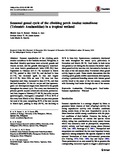Reproduction, early development, and larval rearing of the climbing perch Anabas testudineus (Teleostei: Anabantidae) in captivity
- Global styles
- MLA
- Vancouver
- Elsevier - Harvard
- APA
- Help

View/
Date
2023-06Page views
1,431ASFA keyword
AGROVOC keyword
Taxonomic term
Metadata
Show full item record
Share
Abstract
Induced spawning, early development, and larval rearing of the climbing perch Anabas testudineus were examined under captive conditions. Five female climbing perch [125.33 ± 3.27 mm standard length (SL); 70.67 ± 5.59 g body weight (BW)] were each paired with apparently mature males (108.50 ± 3.97 mm SL; 39.27 ± 4.70 g BW) and induced to spawn with 5,000 IU human chorionic gonadotropin (hCG) + 0.5 mL Ovaprim/kg BW. All hCG + Ovaprim-injected fish spawned 9 – 11 h after hormone administration but saline-injected fish (control group) failed to spawn. Mean egg production per female, fertilization and hatching rates, and larval production per female were 7,667 ± 1,313, 98.11 ± 1.63%, 61.01 ± 19.92%, and 4,435 ± 1,041, respectively. Fertilized eggs (1.52 – 1.96 mm in diameter) were almost spherical, non-adhesive, transparent, and buoyant due to a large, single oil globule (515 ± 33 µm in diameter). First cleavage appeared 30 min post-fertilization (MPF) and egg development lasted for 20 – 24 h post-fertilization (HPF) (29°C). Newly hatched climbing perch larvae [1.73 ± 0.08 mm in total length (TL)] with yolk volume (YV) and oil globule volume (OGV) of 0.545 ± 0.104 mm3 and 0.072 ± 0.013 mm3, respectively had no pigmented eyes or functional mouth parts and digestive tract, and immobile with the yolk sac pointed upward. Eyes became pigmented and both mouth and anus opened in 1 d old larvae (2.09 ± 0.04 mm TL) in preparation for exogenous feeding. Except for body depth (BD) and pre-anal length (PAL), a general increase in TL (1.73 – 3.72 mm), eye diameter (ED) (0.164 – 0.378 mm), head length (HL) (0.205 – 0.923 mm), and mouth gape (MG) size (0.308 – 0.552 mm) was observed, coinciding with yolk resorption in 7 d post-hatched larvae. Climbing perch larvae were reared at four stocking densities (25, 50, 75, 100 larvae L-1) and fed solely on live food (Brachionus rotundiformis from days 2 to 12 and Artemia nauplii from days 13 to 40) or co-fed live food and microparticulate diet (MPD) (Artemia nauplii from days 2 to 15 and Artemia + MPD from days 16 to 40). Mean survival rates at lower densities (25 – 50 larvae L-1) were significantly higher than those reared at 75 and 100 larvae L-1 (P < 0.05). Furthermore, climbing perch larvae co-fed Artemia nauplii and MPD showed better survival (28.67 – 81.00%) than those fed solely on live food (24.88 – 64.00%). However, at the end of the 40 d trial period, growth parameters did not vary significantly among densities (P > 0.05), except for the condition factor in larvae co-fed Artemia nauplii and MPD. Taken together, results demonstrate the effectiveness of hCG + Ovaprim for captive breeding and observations on the early development of climbing perch, and the feasibility of rearing the larvae at 25 – 50 L-1 on a combination of Artemia nauplii and MPD under laboratory conditions.
Suggested Citation
Aya, F., Gutierrez, R. C., & Garcia, L. M. (2023). Reproduction, early development, and larval rearing of the climbing perch Anabas testudineus (Teleostei: Anabantidae) in captivity. Philippine Agricultural Scientist , 106(2), 197-207. http://hdl.handle.net/10862/6449
Type
ArticleISSN
0031-7454Collections
- Journal Articles [1258]
Related items
Showing items related by title, author, creator and subject.
-
Towards reviving the production of Philippine native aquatic species
The overexploitation of native aquatic species mainly for household consumption, not to mention the habitat loss and introduction of invasive alien species in major inland water bodies of the Philippines, has resulted in ... -
Seasonal gonad cycle of the climbing perch Anabas testudineus (Teleostei: Anabantidae) in a tropical wetland
Bernal, Rieziel Ann D.; Aya, Frolan ; de Jesus-Ayson, Evelyn Grace T.; Garcia, Luis Maria
; de Jesus-Ayson, Evelyn Grace T.; Garcia, Luis Maria  (Springer Verlag, 2015)
Seasonal reproduction of the climbing perch Anabas testudineus in the Candaba wetland, Philippines, is described. Monthly specimens were collected, gonads and viscera excised, and the gonads histologically examined. Low ...
(Springer Verlag, 2015)
Seasonal reproduction of the climbing perch Anabas testudineus in the Candaba wetland, Philippines, is described. Monthly specimens were collected, gonads and viscera excised, and the gonads histologically examined. Low ... -
Fatty acid composition of Nile tilapia Orechromis niloticus muscles: A comparative study with commercially important tropical freshwater fish in Philippines
Suloma, Ashraf; Ogata, Hiroshi Y.; Garibay, Esteban S.; Chavez, Denny R.; El-Haroun, Ehab (AquaFish Collaborative Research Support Program, 2008)
Six tropical freshwater species were collected from Philippines in order to study the characteristic of polyunsaturated fatty acids distributions. 16:0 and 18: l n-9 were the predominant saturated fatty acid (SFA) and ...
(AquaFish Collaborative Research Support Program, 2008)
Six tropical freshwater species were collected from Philippines in order to study the characteristic of polyunsaturated fatty acids distributions. 16:0 and 18: l n-9 were the predominant saturated fatty acid (SFA) and ...





